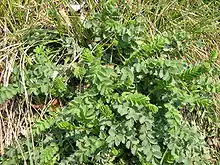Sanguisorba minor
Sanguisorba minor, the salad burnet, garden burnet, small burnet, or burnet, is a plant in the family Rosaceae that is native to western, central and southern Europe; northwest Africa and southwest Western Asia; and which has naturalized in most of North America.[1][2]
| Sanguisorba minor | |
|---|---|
 | |
| Scientific classification | |
| Kingdom: | Plantae |
| Clade: | Tracheophytes |
| Clade: | Angiosperms |
| Clade: | Eudicots |
| Clade: | Rosids |
| Order: | Rosales |
| Family: | Rosaceae |
| Genus: | Sanguisorba |
| Species: | S. minor |
| Binomial name | |
| Sanguisorba minor | |
| Synonyms | |
|
Poterium sanguisorba | |


Salad burnet is a perennial herbaceous plant growing to 40–90 cm tall, typically found in dry grassy meadows, often on limestone soils. It is drought-tolerant, and grows all year around (remains evergreen in cooler temperatures).
Salad Burnet also has a respectable history, called a favorite herb by Francis Bacon, and was brought to the New World with the first English colonists, even getting special mention by Thomas Jefferson.
Usage
Culinary
Young burnet leaves are used as an ingredient in both summer drinks,[3] salads, dressings, and sauces having a flavor described as "mildly cucumber, a bit tart, a little hot"[4] and is considered interchangeable with mint leaves in some recipes, depending on the intended effect. Typically, the youngest leaves are used, as they tend to become bitter as they age.
Decoratively
Burnet flowers in early summer. The unusual crimson, ball-shaped bloom clusters are generally removed to encourage leafy growth, and the cut flowers are used in floral arrangements.
Medicinally
Salad burnet has in the past been used medicinally in Europe to control bleeding.[5]
Salad burnet has the same medicinal qualities as medicinal burnet (Sanguisorba officinalis). It was used as a tea to relieve diarrhea in the past.
References
- "Link to ITIS entry". Retrieved May 1, 2012.
- "Link to EOL entry". Retrieved May 1, 2012.
- "Sanguisorba minor". BBC Gardeners' World Magazine. Retrieved 2020-10-01.
- Lima, Patrick. (2001). Herbs : the complete gardener's guide. Forsyth, Turid. Willowdale, Ont.: Firefly. ISBN 1-55209-624-6. OCLC 64630388.
- Bown, Deni (2002). The Royal Horticultural Society New Encyclopaedia of Herbs & Their Uses. London: Dorling Kindersley Limited. ISBN 0-7513-3386-7.
External links
- Sanguisorba minor in the CalPhotos Photo Database, University of California, Berkeley
 Media related to Salad Burnet (Sanguisorba minor) at Wikimedia Commons
Media related to Salad Burnet (Sanguisorba minor) at Wikimedia Commons